Sage-grouse are a lekking species, in which many males cluster together to court females from small display territories. Each male performs an elaborate, stereotyped visual and acoustic display, and females are free to ‘shop around’ for mates. Males do not provide any resources or parental care, so we think a female chooses her mate for the genetic material he will pass on to her offspring. In spite of decades of research on sage-grouse, we still have much to learn about what makes certain males attractive. Evidence points to the acoustic signals being important; this forms the basis of much of the research program in Professor Gail Patricelli’s lab. In 2006 we began a detailed study of sexual signaling near Lander, Wyoming.
Here’s a quick video of the spectacular display of the male sage-grouse. To see more, please visit my Youtube channel as well as the Patricelli Lab Youtube channel. You can also find links to additional photo galleries on my Photos page.
How do males adaptively vary their displays?
Models of sexual selection usually assume individuals have a single value for a given trait, and although animals typically vary their displays, this variation is often considered noise. We are attempting to understand how males might tactically alter their signalling behavior. We employ a combination of extensive field observations of mating success, video and audio recordings of courtship behavior, and experimental introductions of a realistic robotic female grouse that we can use to elicit changes in male display. First, we asked how males try to optimize both display rate and display amplitude (we believe females prefer both more and louder displays, but these two traits may negatively covary). We found that only non-preferred males faced this trade-off, while preferred males seemed to be able to increase both quantity and quality of displays. This study was recently published in Behavioral Ecology. Secondly, we will see how males use the unique directionality of their acoustic displays, and ask whether successful males are better able to aim their signals at the intended female receivers. The analysis for this is ongoing, and has led to additional undergraduate and post-graduate research projects measuring side biases in behavior in the sage-grouse (akin to left-handed/right-handed phenomena in humans) which are now published in the journal Animal Behaviour.
Our current research is focusing on further understanding variation within and among males in their display effort. If females prefer males that “work hard”, why shouldn’t males always display at their maximum rate? We are using economic models of bargaining and negotiation to try to understand the interactions between males and females that might dictate how hard males should court and how long they should persist in courtship. Leks are great places to understand how market forces might affect courtship- the lek can be thought of as a large open-air bazaar where both males and females have some control of different stages in the courtship process, and both may have outside options that may influence their bargaining behavior. Our first prospectus on this framework was published in Current Zoology in 2011, with a broader framework for considering plasticity in courtship displays here.
While examining sound spectrograms from our microphone array, we found evidence that males were in fact producing two simultaneous, non-harmonically related tones in the whistle. This points to a two-voiced system in which the syrinx– analogous to our larynx– has two sites of sound generation (although a phenomenon called biphonation could also account for the two tones). This was not known for grouse (in spite of decades of work by other researchers on sage-grouse vocal displays), or, in fact, from the galliform (a.k.a chicken-like) birds at all, and has initiated research on how sage-grouse and related birds make sounds. Our first paper describing this work was published in the Journal of Experimental Biology in 2009.
The mechanical sounds mentioned earlier have received relatively little attention from biologists. We have collaborators working on the mechanism of frequency modulation in these stridulations (more on this when it is ready for prime-time). Along side this mechanistic work, we are quantifying variation within and among males to determine whether there is any relationship between time or frequency components and male mating success, whether males might vary these depending on social context, and whether they could potentially be informative in individual identification. These analyses were led by our former undergraduate Becca Koch who Becca presented a preliminary analysis at the recent Animal Behavior Society meeting in Bloomington, Indiana and has published results in the Auk.
How does the environment affect signaling?
While we expect much of the perceived differences in male displays are due to differences among the males themselves, we do know males fight for territories; another goal of our research is to compare territory quality- i.e. how well sound propagates across the substrate, and whether this relates to the mating success of males. We first mapped male territories and identified favored display sites. We then went in at night to broadcast sound from these sites (as well as less preferred sites within and outside of territories), and recorded how much sound made it to microphones placed in a ring around this omnidirectional speaker,and to microphones in the array. Analyses on these questions are ongoing.
Links between Foraging Ecology and Display Behavior.
Much of the past work on male courtship effort in sage-grouse has had either implicitly or explicitly considered the idea that display is energetically expensive, and that males may come to the lek with differing energy budgets that may determine their performance level for females. But why should males vary? Some males might be less capable because of disease or underlying genetics, but at a basic level, the energy males come to the lek with may depend on what they eat the day before. It turns out grouse foraging ecology is every bit as interesting as their on-lek behavior.
For several years we have collaborated with Prof Jen Forbey (Boise State), an expert in plant-herbivore interactions. The grouse rely exclusively on sagebrush (genus Artemesia) during the winter, and this plant is full of toxins. More than that, it can increase production of toxins when it gets nibbled on by grouse, and can even trigger nearby plants to become less palatable too. We are interested in questions such as whether some males choose better quality plants or search the landscape differently. Do the males with better foraging skills also show better responsiveness to social conditions on the lek, or do they just have more energy to burn and show fewer constraints on their display? Also, we are examining whether the quality of sage around different leks might influence the display behavior we see on those leks. Do larger leks become worse for birds that are stuck eating lower quality food?
To begin investigating what male sage-grouse are doing for the bulk of the day when they are not on-lek displaying for females, we began putting advanced telemetry tags on some of our birds. These tags, made by Encounternet, have both a GPS tracker and an accelerometer (the same technology that your smartphone or fitness tracker has to sense movement and orientation). This will let us know not only where birds are going but what they are doing in certain locations. Our preliminary tests suggest we can typically tell the basic behaviors such as walking, foraging, and resting. We describe this technology as part of a larger review of the powerful new tools being used to help understand grouse ecology.

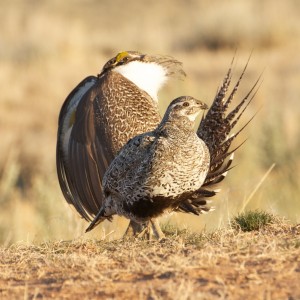
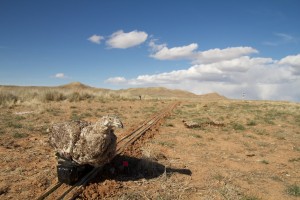
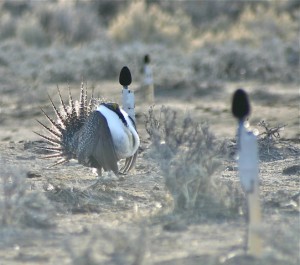
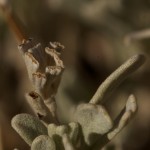
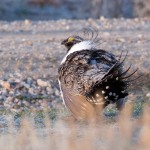
This is very nice work, I am engineering student working on microphone array, please will you give me information of your microphone array experiment.
Thanks for your interest! I’ve sent you some additional details by email.